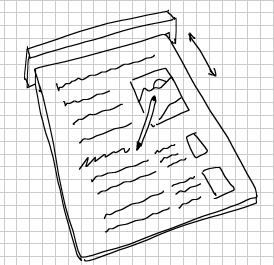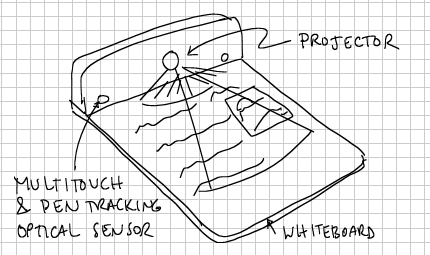The New York Times has an interesting article today on the future model of digital books. The article ponders book concepts that go beyond static media and include video, Twitter streams and the like. In particular, they focus on a new venture by Dradley Inman, called VBook.tv, that’s attempting to build what I’d call multi-media digital content.
I’ve been thinking a lot about digital books, content and devices lately and I’ve been wondering if there’s not a sweet spot here for more static digital content rather than video-ladden ones. Sounds like I’m suggesting for the market to go the wrong way, but hey, why not think through the possibilities on this lazy Sunday morning.
Here goes.
First, let me set the stage. I’m thinking here in terms of a device of some kind that might be appropriate for K-8 classes and the like here in the US and abroad. I’m thinking of something dirt cheap, durable, and trivial to use and manage, yet still holds the properties of digital content that we know and love: namely the ability to send and receive digital pages (like pages from a book) and in some way support user interaction with the content. In terms of user interaction, I’m contemplating something simple. Very simple. Let’s say not more interaction than you might see with a kid writing in a workbook. This means animations, videos and the like are not at the top of the priority list. It’s fine if they can be supported, but what if they aren’t considered that important? How much can be done.
Off and on I’ve seen TV news reports where kids in schools (here and the US) are shown using a small chalkboard or whiteboard. Makes sense. They are dirt cheap, rugged, mobile, don’t consume many resources (electricity, paper, etc), and best of all are usable. The devices are used to write out little problems or write out answers and the like. For instance, they might work out the solution to a math problem or practice spell a word. Nothing substantial. Primarily throwaway content, yet still useful practice work.
Anyway, this has gotten me thinking: What if there was a whiteboard device like this that students could use which supported handwritten input and which also was capable of receiving and displaying workbook like content (probably a page at a time) that they could mark up and then submit their work back on should the need arise?
So I’m thinking of something very sheet-of-paper like, which is not exactly up to the level of an eBook device, but for the sake of this discussion, let’s keep going.
Here’s a quick sketch of the general concept: A student is sitting on the floor handwriting an answer to a series of problem which are distributed from the school’s computer infrastructure to the student’s device and back. Optionally, the student could write out the problem too, but I want to see if it’s possible to mix up the capabilities of a whiteboard like device with those of a fairly static workbook that’s fed one page at a time to a handheld device.
Now, if money is no issue, there are already great devices that can fit this bill. A slate Tablet PC is one of them. The only problem(s)? They’re a bit too expensive for most school budgets, they’re not exactly robust, they consume so much power they need to be charged at least once during the day, and they, quite frankly, are too heavy for most young kids to use.
Now an Amazon Kindle like device is going the right direction and if it supported pen input it would be even better. The Kindle device is not a bad match overall, although the eInk display is kind of small. That’s the one catch–at least for this thought experiment.
I’ve wondered, also, if it’s not possible to build a super thin and super light Tablet PC slate like this that’s more content oriented than let’s say OS oriented. After all, we don’t really need a generic computing device here. But, hey, that would be really cool.
OK. Here’s one design sketch I came up with.
It’s a single white board with a persistent display technology that can be activated with a sliding, single array dot-matrix like print head or a pen.
Some may ask: Why not use one of those digitizing pen like devices where you can write or draw on paper and behind the scenes the pen is logging every move you make? The thing is I’ve tried devices like this and at least to me they all come up short. The problem is that you’re not digitizing what you actually see. The pen, let’s say if there is one to write on paper with, might place ink on the paper, but the digitizer might not be picking up the strokes because you’re not touching hard enough. You don’t know. You could learn how to use the tool correctly, but my take is that a better approach is for the pen to digitize the “ink” into the display and the display is what records the strokes.
To pull this off you could have an EM-like digitizer for the pen input and even a touch technology to boot. Both could be thin. Both could be designed with lower power in mind. Neither requires a lot of compute power.
Now how does a workbook page get rendered on a whiteboard device like this? Again, I don’t know. This is just a thought experiment. One idea is that there might be an array on the slider that injects on or off values to the mythical display. I’m thinking black and white here at a high resolution–something print grade: 600dpi, for example.
To keep things cheap and simple, the “print head” is manually slid across the surface of the whiteboard and as it is moved, position information is tracked and given to the print head so it can appropriately render the page it needs to. I have no idea if enough precision could be engineered so a sliding mechanism like this would work, but oh well.
Along these lines, I’ve wondered if you couldn’t use a coil/inductor approach to generate small amounts of current into the device as the slider is moved back and forth. In other words, maybe it could double as a generator. So in the morning or whenever, students could slide the print head back and forth a handful of times to recharge the unit. Yeah, probably kind of silly, but just a thought.
Now for the user I’m wondering if the pen a student uses could draw on the rendered page in some similar fashion to the sliding print head. I’m not sure if the pen digitizing process needs to be lower resolution or not, but it definitely could be.
Again, the content displayed would definitely be very print paper minded. No animation by necessity though it would be OK I guess. And it would be kind of clunky to use. Slide the bar to render a page. Handwrite or touch somewhere to provide input, press something or other to upload content or slide the bar again to get another page. It definitely would be slow to flip through a book, but that’s not the intent here.
Yes, a device like this would probably be pretty unimpressive to most of us that use PCs all day, but who knows maybe we could use one or more to display individual pages of one or more books at a time.
I also haven’t worked through the processing power requirements to see if it would even be feasible to update or scan this mystical whiteboard display device to see if any of this would work. No idea, though it seems like it wouldn’t take much processing power. I think it would be down in the Arm processor category.
I imagine if WiFi is supported even it could be supported by an Arm chipset.
Oh, here’s one other twist on this idea that probably eats up way too much power, but is something that might have value somewhere. What about a device with a built in, micro-short-throw projector that displays the content and some sort of optical sensor that could track a handwriting pen as well as even multi-touch.
Yeah, kind of an odd device, a portable projector-slash-multi-touch computer. If everything fits in the of the device, who knows, I guess you could carry it anywhere and use it with any horizontal surface.
Now with this approach, there’s animation and video support, but kind of cool I think. It doesn’t take much to imagine the endcap being self-contained and something that could be placed on other surfaces like a desk, for instance.
Just an idea.



How dynamic does a digital book need to be? http://tinyurl.com/c6anjb Some interesting ideas from Incremental Blogger. #feedly
This comment was originally posted on Twitter